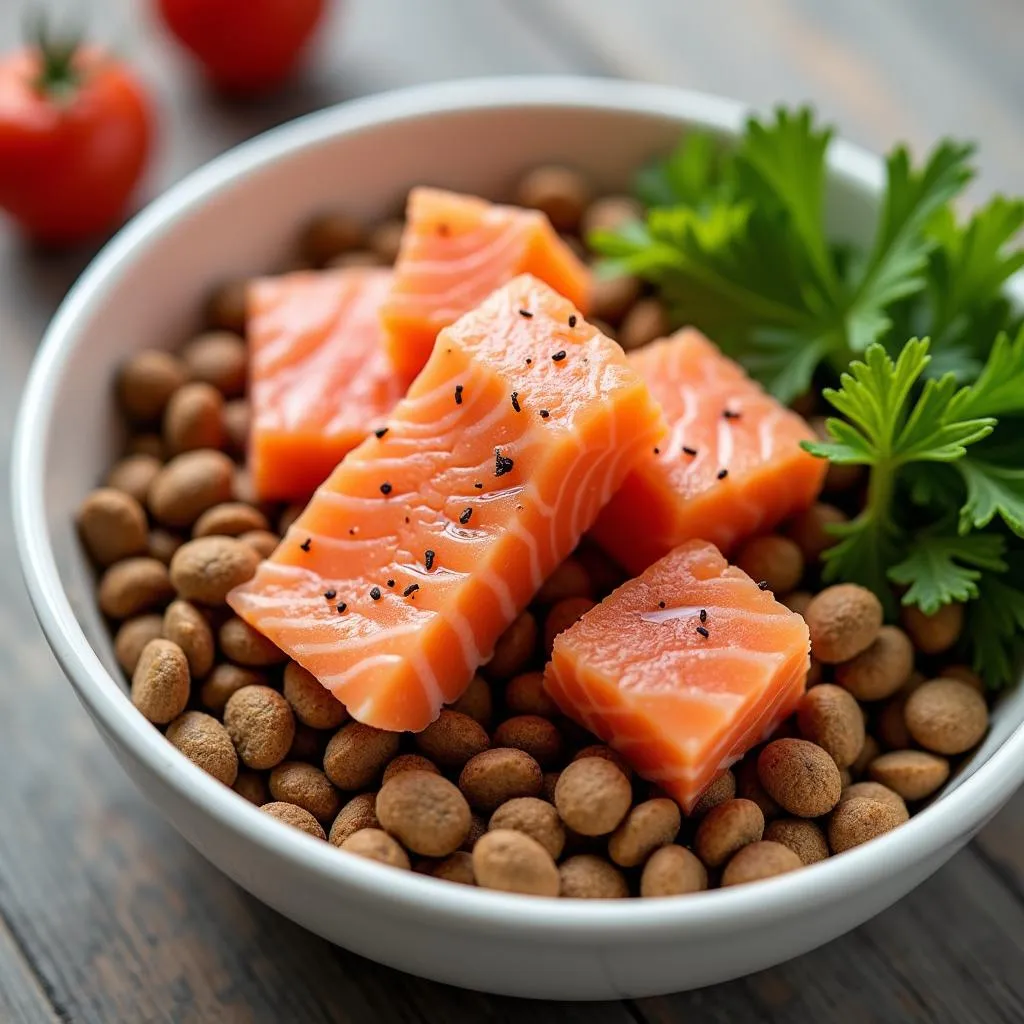Have you ever caught your dog staring longingly at your dinner plate, hoping for a bite of your salmon? Well, you’re not alone! Many dog owners find themselves wanting to share their delicious salmon meals with their furry friends. But is it safe for dogs to eat salmon? And if so, what are the best ways to incorporate it into their diet?
What is Salmon Topper for Dogs?
Salmon topper for dogs is a type of dog food supplement that is made from salmon. It is typically used as a topping for dry dog food, but can also be given as a standalone treat. Salmon is a great source of protein, omega-3 fatty acids, and other essential nutrients that are beneficial for dogs.
Benefits of Salmon Topper for Dogs
There are many benefits to feeding your dog salmon topper. Some of the most notable benefits include:
- Improved Coat Health: Omega-3 fatty acids in salmon help to promote a healthy, shiny coat, and reduce shedding. They are also known to help improve skin conditions like eczema and allergies.
- Joint Health: The omega-3 fatty acids in salmon have anti-inflammatory properties that can help to reduce joint pain and stiffness. They can be especially helpful for dogs with arthritis.
- Brain Health: Salmon is a good source of DHA, a type of omega-3 fatty acid that is essential for brain development and function.
- Improved Digestion: Salmon is rich in protein, which helps to keep your dog’s digestive system healthy and functioning properly.
- Weight Management: Salmon is a lean protein source that can help your dog maintain a healthy weight.
Types of Salmon Topper for Dogs
Salmon topper for dogs comes in a variety of forms, including:
- Fresh Salmon: This is the most natural form of salmon topper, and it is often the best option for dogs with sensitive stomachs. However, it is important to choose fresh salmon that is specifically intended for human consumption, and to cook it thoroughly before feeding it to your dog.
- Frozen Salmon: This is a convenient option for dog owners who want to store salmon topper in the freezer for later use. Frozen salmon is often a good choice for dog owners who do not have access to fresh salmon.
- Canned Salmon: Canned salmon is a more affordable option than fresh or frozen salmon, and it is a good source of protein and omega-3 fatty acids. Be sure to choose canned salmon that is packed in water or oil, and avoid salmon that is packed in brine or soy sauce.
- Salmon Oil: Salmon oil is a supplement that is made from salmon. It is a concentrated source of omega-3 fatty acids, and it is often added to dog food to improve coat health, joint health, and brain health.
How to Choose the Right Salmon Topper for Your Dog
When choosing a salmon topper for your dog, it is important to consider the following factors:
- Quality: Always choose salmon topper that is made from high-quality salmon. Look for brands that use wild-caught salmon, and avoid brands that use farmed salmon or salmon that is treated with antibiotics.
- Ingredients: Make sure that the salmon topper you choose does not contain any artificial flavors, colors, or preservatives. It is also important to avoid salmon topper that contains grains, fillers, or other ingredients that are not good for dogs.
- Your Dog’s Needs: If your dog has any allergies or sensitivities, be sure to choose a salmon topper that is formulated for dogs with special dietary needs.
How Much Salmon Topper to Feed Your Dog
The amount of salmon topper you should feed your dog will depend on their age, weight, and activity level. It’s always best to consult with your veterinarian about the appropriate amount of salmon to feed your dog.
 Salmon Topper for Dog Food
Salmon Topper for Dog Food
Is Salmon Topper Safe for All Dogs?
While salmon is generally safe for dogs to eat, there are a few things to keep in mind:
- Bones: Never feed your dog salmon bones. Salmon bones are very sharp and can cause choking or internal injuries.
- Allergies: Some dogs are allergic to salmon. If you notice any signs of an allergic reaction, such as itching, swelling, or vomiting, stop feeding your dog salmon and consult with your veterinarian.
Tips for Feeding Your Dog Salmon Topper
Here are a few tips for feeding your dog salmon topper:
- Cook it thoroughly: Salmon should be cooked thoroughly before feeding it to your dog. This will help to kill any harmful bacteria.
- Remove the skin: The skin of salmon can be difficult for dogs to digest.
- Start with a small amount: When introducing salmon topper to your dog’s diet, start with a small amount and gradually increase the amount over time.
- Monitor for any side effects: Watch your dog carefully for any signs of adverse reactions after feeding them salmon topper.
Conclusion
Salmon topper can be a delicious and nutritious addition to your dog’s diet. Just be sure to choose high-quality salmon topper, feed it in moderation, and monitor your dog for any signs of adverse reactions. If you have any questions or concerns about feeding your dog salmon topper, be sure to consult with your veterinarian.
Remember, a healthy and happy dog is a happy family! We encourage you to share your own tips and stories about feeding your dog salmon topper in the comments below!
Leave a Reply
You must be logged in to post a comment.